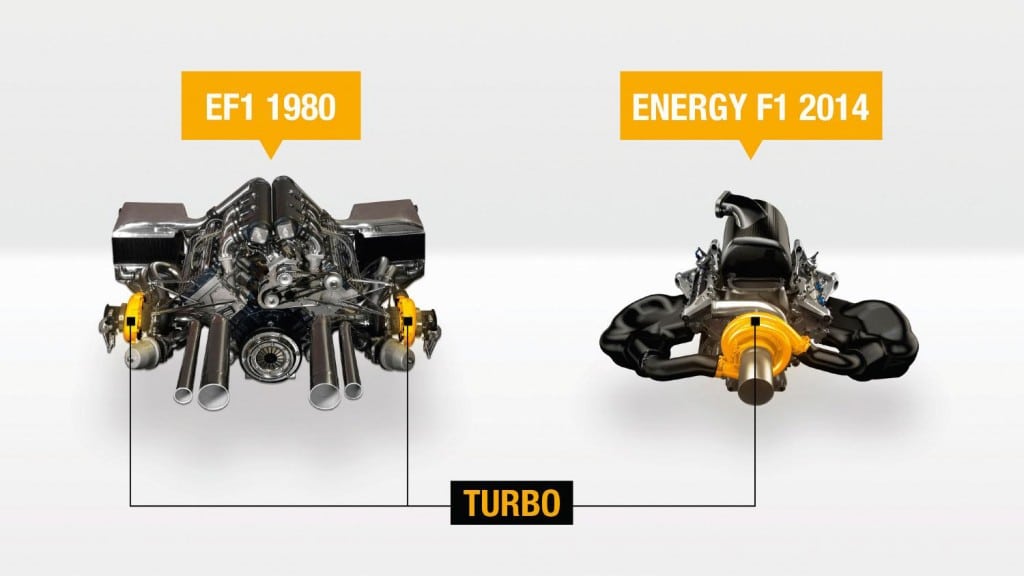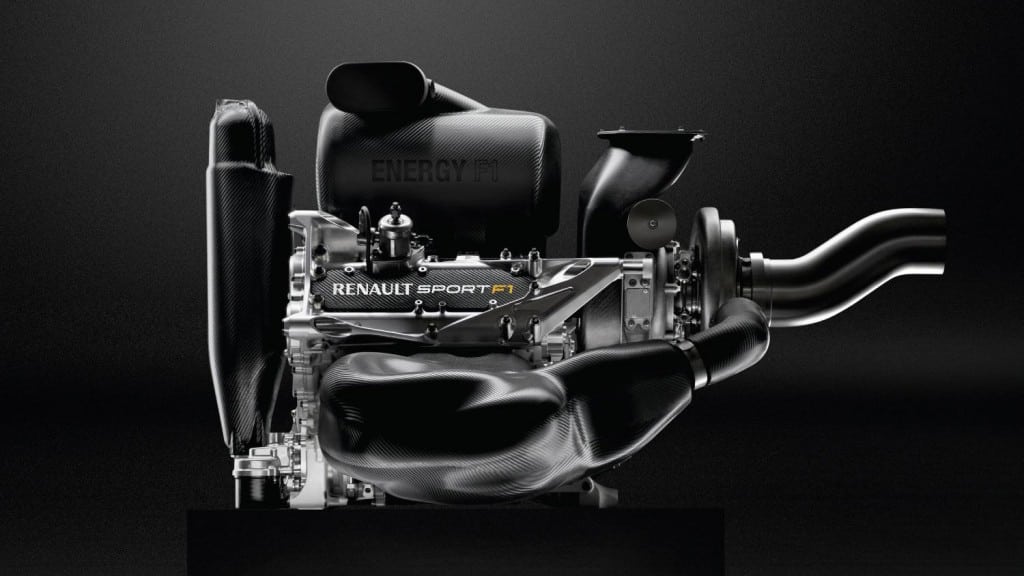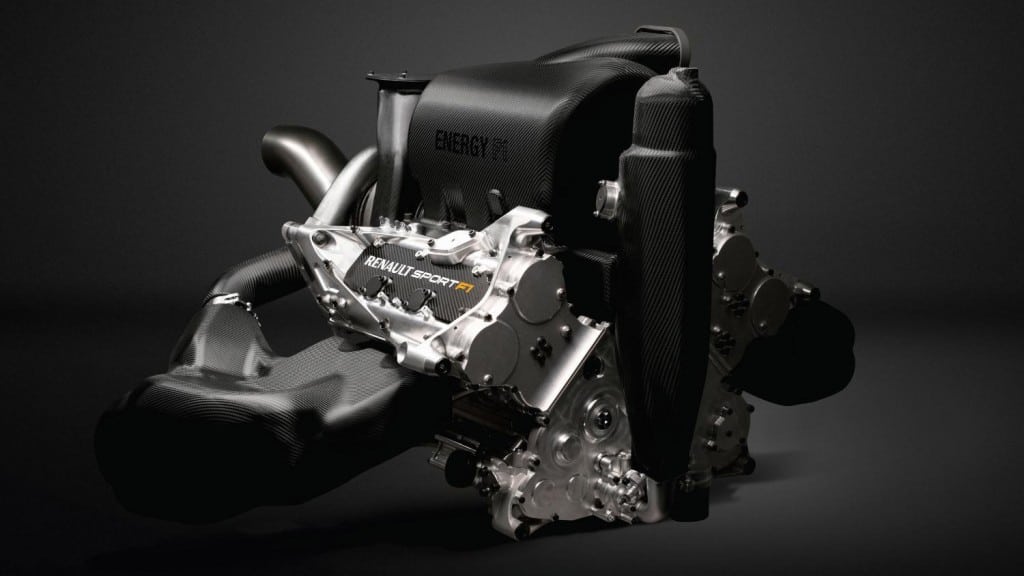It’s hard to imagine a tiny little six-cylinder engine that weighs less than many four-cylinder offerings, yet produces 760 horsepower, revs to 15,000 RPM, and yet displaces less than a two-liter Coke bottle in cylinder volume. Yet this is exactly what the new Formula One engines for the 2014 season can do.
 Renault, one of the three F1 engine suppliers, released information about their engines for this year’s season – or at least as much as they can release – to show us how very high-tech this new race season will be.
Renault, one of the three F1 engine suppliers, released information about their engines for this year’s season – or at least as much as they can release – to show us how very high-tech this new race season will be.
FIA, which ovesees F1, introduced a double restriction for the 2014 race season. First, the fuel quantity for each race is limited to 100 kilograms (220 pounds), a thirty-five percent reduction from last year. They’ve also introduced a flow rate restriction, requiring that fuel use be restriction to 100 kg/h. This forces turbo boosting to about 3.5 bar and forces the race teams to come up with other ways to speed engine revs and power output. This has meant that engines have both shrunk in displacement and increased in power output per fuel drop.
Just looking at a graphic showing one engine over the other illustrates how much smaller and more streamlined the 2014 engine is compared to the big V8s of 1980:
Further restrictions, such as the five engines per driver, per year, continue the difficulty, requiring the Formula One engineers to not only create more powerful engines, but to also create reliable, re-usable ones. The most difficult part was to make the engine run at extremely high pressures (around 200 bar), which produces a “knock challenge” for the turbo – if the turbo produces knock within the combustion chamber, at those pressures, the engine will literally explode.
Several things were improved to make all of this feasible. The turbo winds up at around 100,000 rpm, which produces a lot of heat – never mind the high-compression engine itself and its extreme heat production. This heat is converted via a thermal system into electricity and stored in an energy pack behind the engine. This energy can be used to add power to the wheels via a hybrid system (the F1 car now has about 160 of its horsepower in electric motor boosting) and to keep that turbo wound up to speed during braking and cornering. Keeping the turbo wound up is both more fuel efficient and reduces turbo lag to nearly zero, which improves performance.
To further improve energy recovery, the old KERS system has been replaced with a dual recovery system. One is a motor generator unit-heat (MGU-H), which recovers energy from the exhaust system, and the other is the MGU-K (kinetic), which recovers braking energy. If either of these systems fails, the car can still race, but is basically no longer competitive because of the loss of energy recovery and/or power from the propulsion motor, which is critical to the car’s speed capability coming out of corners.
The energy recovery and return system acts as a wastegate, though the engine is also equipped with a standard wastegate as a just-in-case measure and to bleed off excess heat that cannot be converted fast enough. Basically, the MGU-H absorbs power from the turbine shaft to convert heat from exhaust gases as well as control the turbocharger’s speed.
Compared to last year, the energy being used to improve the F1 car’s performance this year is about ten times greater. Batteries are required to weigh at least 20 kg (44 pounds) and shielding had to be improved throughout the car because the huge amounts of electromagnetic forces being created interfere with sensors.
Now, here’s where it all comes together. The fuel restrictions mean that there is only enough fuel in the race to power the car for about an hour, flat out. Even at only 1.6-liters of displacement. Considering a Grand Prix can last as long as twice that, it’s very important that Formula 1 teams be frugal with their fuel.
During acceleration, the turbo is at maximum (100k rpm), the MGU-H is producing power from exhaust heat and sending that power to either the battery or the MGU-K, which is the motor on the crankshaft that aids power output to the wheels (up to 160 hp). The MGU-K can either help conserve fuel or boost the total output for acceleration.
When the driver lifts off the throttle for a corner, the MGU-K converts to a generator and acts as an engine brake, saving physical brakes as much as possible, and sending the recovered energy to the battery and the MGU-H. The MGU-H, at this point, is now a motor keeping the turbo wound up to speed to avoid turbo lag.
Coming out of the corner, the driver accelerates again and everything swaps back, with the MGU-K aiding acceleration once again.
All of this is monitored on-board the car and by the pit engineers. The sweet spot the team is aiming for is to find the minimum lap-time frontier, that border between the physically possible and the impossible for the complete system on that particular track.
For this reason of balance, this season will be one of the first times where we’ll consistently see faster qualifying laps than we see actual race lap times. During qualifying, there are no fuel restrictions and drivers will go flat out. During the Grand Prix itself, however, conservation is as important as speed, so we’ll see more moderate times and a lot more strategy on the field.
It’s going to be an interesting year. The first Grand Prix in the F1 series this year will be on March 16 in Australia.










